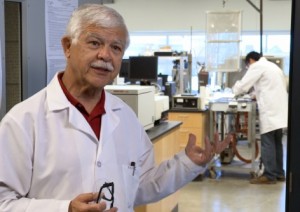Iowa State University and Ames Laboratory researchers are working on the development of next-generation insulation materials for applications in buildings, freezers, refrigerated trucks and other cooling and heating devices using nanotechnology.
 Mufit Akinc is leading a research effort to find and develop better insulation materials for buildings, appliances and other heating and cooling applications. Photo by the Iowa Energy Center.
Mufit Akinc is leading a research effort to find and develop better insulation materials for buildings, appliances and other heating and cooling applications. Photo by the Iowa Energy Center.
The main objective of the research is to substitute conventional insulating materials such as synthetic silica, fiberglass and foam with better materials, which could result in a large amount of energy savings.
The researcher and his team made use of vacuum insulation panels with a thickness of one inch and filled it with an insulating powder vacuum sealed within a foil cover. Using vacuum, resulted in improvement of the powder’s insulating properties as air molecules capable of heat transfer were eliminated. This proves that the insulating power of an inch-thick panel can be as much as 10 inches of foam.
Fumed silica is the most common powder used within the panels. However, these panels are expensive for certain applications like insulating homes and buildings due to the costs involved in producing synthetically nano-sized fumed silica. As a result, the research group started studying the density, surface area, porosity and other properties of inexpensive alternatives such as diatomite, glass bubbles, fly ash and glass fiber.
Diatomite was observed to be the most promising material. It is nothing but the fossilized remains of diatoms, single-celled algae group. This type of algae has a silica cell wall and an ability to grow anywhere in the presence of sunshine and water. The skeletons of algae left behind convert into diatomite filled with nanopores.
The research work along with the work of two other Iowa State researchers is supported by the Iowa Energy Center.
The Iowa Energy Center is funded by the state of Iowa to support economic development through advances in renewable energy and energy efficiency. Anything we can do to improve thermal insulation of buildings would go far to improve energy conservation in the United States.
Mark Petri, Director of the Iowa Energy Center
References